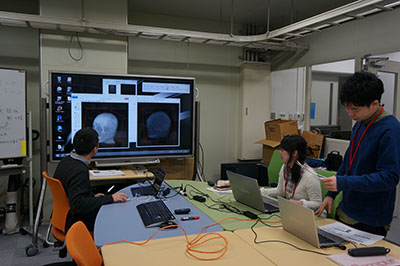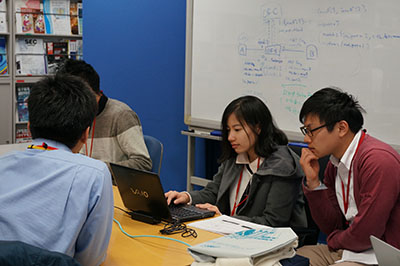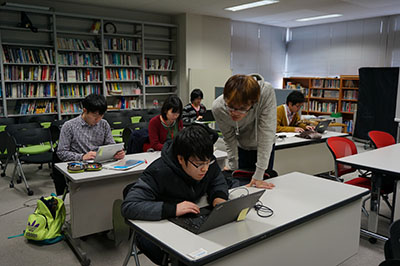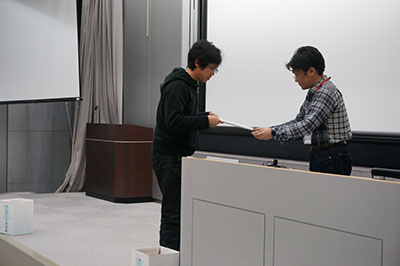Graduate School of Information Science, NAIST
Spring Seminar
Feb. 23-24, 2017
Spring Seminar 2017 will be held on the Graduate School of Information Science, NAIST, on February 23-24. You can experience the cutting-edge research on Information Science during this Spring Seminar.
We are looking forward to your application!




| Date |
Feb. 23 - 24, 2017 |
| Venue |
Graduate School of Information Science, NAIST (Takayama 8916-5, Ikoma, Nara 630-0192, Japan), or Online |
| Intended audience |
Education higher than undergraduate including non-academic applicants who are planning to become IS students.
If you are not a candidate, please apply the Lab tour |
| Capacity |
Depends on each theme (please check the table below).
If the number of applicants exceeds the capacity, a selection process will be done by the corresponding laboratory.
NOTE:
Only one theme can be applied for each laboratory.
|
| Admission fee |
FREE! However, we don't cover any travel or accommodation costs. |
| Application form |
|
| Contact us |
Spring Seminar Committee
ss1608[at]is.naist.jp |
- 2017.02.09 Theme assignment notification email is sent.
Confirm the assignment
- 2017.01.31 Application site is closed
- 2017.1.12 Application is started
- 2016.12.22 Website is open and the list of themes is uploaded
- Feb. 23 Thu.
09:20 Registration (IS L1 lecture room)
09:30 - 10:00 Introduction (IS L1 lecture room)
10:00 - 17:00 Seminar (Lab.)
- Feb. 24 Fri.
09:20 - 12:00 Seminar (Lab.)
12:00 - 13:30 Social lunch (Kenshu Hall, in the (yellow) administration building)
13:30 - 16:45 Seminar (Lab.)
16:50 - 17:20 Ceremony (IS L1 lecture room)
-
Develop your original smart sensor node
| Laboratory: |
Computing Architecture
|
| Summary: |
FPGA (Field Programmable Gate Array), a customizable soft hardware, is becoming major in a very wide range of applications, such embedded system and date centers. In this seminar, we develop a small but smart sensor node by using an FPGA. Beginners of hardware development are welcome!
|
| Capacity: |
4
|
| Qualification: |
none
|
-
Algorithm design toward molecular robots
-
-
| Laboratory: |
|
| Summary: |
|
| Capacity: |
3
|
| Qualification: |
|
-
Car route navigation by genetic algorithms
| Laboratory: |
Mobile Computing Lab
|
| Summary: |
Genetic algorithms are optimization algorithms using techniques inspired by natural evolution, such as inheritance, mutation, selection, and crossover. Routing for navigation can be optimized by evolving the routes, and as a result, flexible navigation can be realized. In the seminar, the participants will change the objective functions and parameters for the algorithm and see the output route changes accordingly.
|
| Capacity: |
3
|
| Qualification: |
Beginners are welcome
|
-
Simulation: Theory and Practice
| Laboratory: |
Mobile Computing Laboratory
|
| Summary: |
The goal of this project is to gain the ability of developing customized simulators. The project involves learning simulation theory (elements of probability, generating random variables and discrete event simulation approach, etc.) and simulation programming practice.
|
| Capacity: |
5
|
| Qualification: |
Experience in C/C++/Java programming
|
-
Construction of a Parallel Distributed Learning System
| Laboratory: |
Mobile Computing Laboratory
|
| Summary: |
Mobile agents are computer software to execute processes on computers through a network. In addition, recently machine learning such as deep learning has been attracted public attention. In this seminar, the participants will construct a mobile agents-based parallel distributed learing system using a development platform, program library, and several devices such as the Raspberry Pi. The participants will confirm that mobile agents learn, run, and move through a network.
|
| Capacity: |
3
|
| Qualification: |
none
|
-
Open Source Software Development Simulation
| Laboratory: |
Software Engineering Lab
|
| Summary: |
We are using so many open source software like smart phone (e.g., Android OS), ATM (e.g., Linux, Apache HTTP) in our life. That means talented people who can use, build open source software, and join open source software project are requested from now on. This seminar aims to simulatively experience open source software development simulative.
|
| Capacity: |
5
|
| Qualification: |
Beginners are welcome, but having programming experience is a plus.
|
-
Mining Fine-Grained Bug Fix Histories
| Laboratory: |
Software Engineering
|
| Summary: |
How do bugs occur and spread in large-scale software development? Based on previous studies, we will conduct a new study of analyzing bug-fix histories with our fine-grained version control system, Historage. If we can obtain new results and you will be interested in, we can work on writing a paper after this seminar too.
|
| Capacity: |
3
|
| Qualification: |
Programing experience
|
-
Let's find bad parts of software !!!
| Laboratory: |
laboratory for software design and analysis
|
| Summary: |
Many tools on automatically analyzing bad parts and discovering bugs from programs has been developed. In this theme, we use these tools to analyze the source code of browsers such as Mozilla Firefox and Google Chrome. Furthermore, you can analyze the source code of your undergraduate exercises, if you want.
|
| Capacity: |
3
|
| Qualification: |
Programming experience
|
-
Virtual network programing for Cloud computing
| Laboratory: |
Software Design and Analysis
|
| Summary: |
In this seminar, we will learn about virtual network programing, which is an emerging technology for Cloud infrastructures. Cloud computing has been actually brought on by server virtualization, but for the next step, network virtualization has been also focused on. SDN (Software Defined Network) technology, introducing programmability into network infrastructures, has therefore gathered a lot of attention. We will learn how to program virtual networks using OpenFlow, a typical implementation of SDN.
|
| Capacity: |
3
|
| Qualification: |
Basic programming skills. Experience in Ruby is preferred.
|
-
| Laboratory: |
|
| Summary: |
|
| Capacity: |
2
|
| Qualification: |
|
-
| Laboratory: |
|
| Summary: |
|
| Capacity: |
2
|
| Qualification: |
|
-
Discovering Knowledge from Bigdata
| Laboratory: |
Augmented Human Communication Lab
|
| Summary: |
Using Apache Spark, we discover knowledges from huge amount of tweets. This lecture includes how to obtain bigdata, preprocessing, knowledge discovering, and visualization. We also discuss for discovering how to earn high quality knowledges.
|
| Capacity: |
2
|
| Qualification: |
Beginners are welcome.
|
-
Introduction to machine learning and its application to a brain computer interface
| Laboratory: |
Augmented Human Communication Lab
|
| Summary: |
We present a introduction to EEG data recording, EEG signal processing, and statistical machine learning which are important for a brain computer interface (BCI). We finally implement a simple BCI system.
|
| Capacity: |
5
|
| Qualification: |
Beginners are welcome.
|
-
Developing useful machine translation system "just for yourself"
| Laboratory: |
Augmented Human Communication Lab
|
| Summary: |
Data-driven machine translation systems attract a great deal of attention.
Such a system learns translation knowledge from a large number of translation examples to translate automatically.
In this seminar, we try to develop a machine translation system that is useful for you, using appropriate translation examples selectively.
|
| Capacity: |
4
|
| Qualification: |
Programming experience in Python, Ruby, or Perl
Command line UI experience
|
-
Individual conversational system
| Laboratory: |
Augmented Human Communication Lab
|
| Summary: |
Artificial intelligence programs such as spoken dialogue system, which
responds to human utterances, are widely used in several situations.
Conversational system that makes conversation with users on a variety
of domains is especially receiving a lot of attention. We try to develop
a conversational system that has your own specified character, by
selecting training data of the system in this seminar.
|
| Capacity: |
4
|
| Qualification: |
Programming experience in Python, Ruby, or Perl
Command line UI experience
|
-
Understanding Your Speech with Automatic Speech Recognition System
| Laboratory: |
Augmented Human Communication Lab
|
| Summary: |
Let's develop a machine that can automatically recognize natural spoken language. We'll start from learning the basic technology (e.g., ""What is human speech from machines point of view?"", ""What challenges in developing speech recognition?"", etc). Finally, we'll work together on developing speech recognition system that understand your speech about your favorite story.
|
| Capacity: |
2
|
| Qualification: |
Beginners are welcome, but having programming experience is a plus.
|
-
OST-HMD calibration with C++ and OpenCV
| Laboratory: |
Interactive Media Design Laboratory
|
| Summary: |
Optical See-Through Head-Mounted Displays (OST-HMDs) display graphics in the user�fs field of view without occluding the scene around them. For Augmented Reality (AR) applications the displayed content must be aligned with the observed scene. As such, the relation between the OST-HMD and the user�fs view must be calibrated to create a good AR experience.
In this seminar the participants will learn and implement a camera calibration routine, a manual calibration routine for OST-HMDs, and apply the results to create an AR application.
|
| Capacity: |
8
|
| Qualification: |
Required:
- C++ programing experience
Beneficial:
- OpenCV programming experience
- Unity programming experience
|
-
Making photorealistic computer graphics from photometric measurement
| Laboratory: |
Optical Media Interface Lab.
|
| Summary: |
Photorealistic computer graphics is an image of computer modeled scenes with a quality as close to real scene as possible. One of the key techniques in it is measuring the photometric properties of a real object based on computer vision technique. In this seminar, the participants can learn computer vision technique to capture the realisticity in real object and computer graphics technique to apply it onto computer modeled scenes.
|
| Capacity: |
3
|
| Qualification: |
Programming experience in C/C++
|
-
Generation of grasping motion by robot arm based on object detection
| Laboratory: |
Robotics
|
| Summary: |
In this seminar, you will learn and experience how to control a robot arm and a robot hand to grasp different objects automatically. The grasping motion will be generated by detecting the size and the sharp of object in real-time. You will have a chance to learn the basic knowledge of robotics, such as robot control, image processing, machine learning, and so on.
|
| Capacity: |
2
|
| Qualification: |
Programming experience
|
-
Image Recognition using Deep Learning and Robot Motion Generation
| Laboratory: |
Robotics Laboratory
|
| Summary: |
In order to implement the service robot that works in our daily lives, we obtain the knowledge to integrate the image recognition using deep learning and a robot motion generation.
|
| Capacity: |
3
|
| Qualification: |
Programming experience
|
-
Bio-inspired robot control and AI
-
| Laboratory: |
|
| Summary: |
|
| Capacity: |
4
|
| Qualification: |
|
-
| Laboratory: |
|
| Summary: |
|
| Capacity: |
5
|
| Qualification: |
|
-
| Laboratory: |
|
| Summary: |
|
| Capacity: |
5
|
| Qualification: |
|
-
Data Science of Human Anatomy
| Laboratory: |
Imaging-based Computational Biomedicine
|
| Summary: |
Medical imaging such as CT or MRI is ubiquitous in hospitals and is an essential tool for diagnosis and treatment planning. Currently, medical imaging is used for checking an individual patient. An emerging research field called 'Computational Anatomy' digs into information buried in medical images of a large cohort to reveal essential questions in population study, e.g., what is the variation of organ shapes in human beings?, what is the characteristic organ shape specific for a certain disease? In this summer camp, the participants will learn basics of computational anatomy and implement simple software by themselves.
|
| Capacity: |
3
|
| Qualification: |
Programming experience is a plus
|
-
Mathematical Science for Image-guided Surgery
| Laboratory: |
Imaging-based Computational Biomedicine
|
| Summary: |
The car navigation system tells you where you are with the assistance of the Global Positioning System (GPS) and is becoming an essential tool for drivers. The same technology is becoming popular in surgery. The surgical navigation system localizes the patient and surgical tools using a 3D tracking sensor, which helps surgeons to identify the position and orientation of the tool with respect to the patient. It improves safety in an accuracy-critical surgery such as needle insertion into a deep target or implantation of an artificial object into the patient's body. In this summer camp, the participants will learn basics of the surgical navigation system using an actual tracking sensor and a human body phantom, as well as discuss about its advantages and disadvantages from the surgeon's perspective.
|
| Capacity: |
3
|
| Qualification: |
Programming experience is a plus
|
-
| Laboratory: |
|
| Summary: |
|
| Capacity: |
5
|
| Qualification: |
|
Lab tour
Please visit Lab Tour.
Please visit Access Map.
Please visit FAQ(in Japanese).




